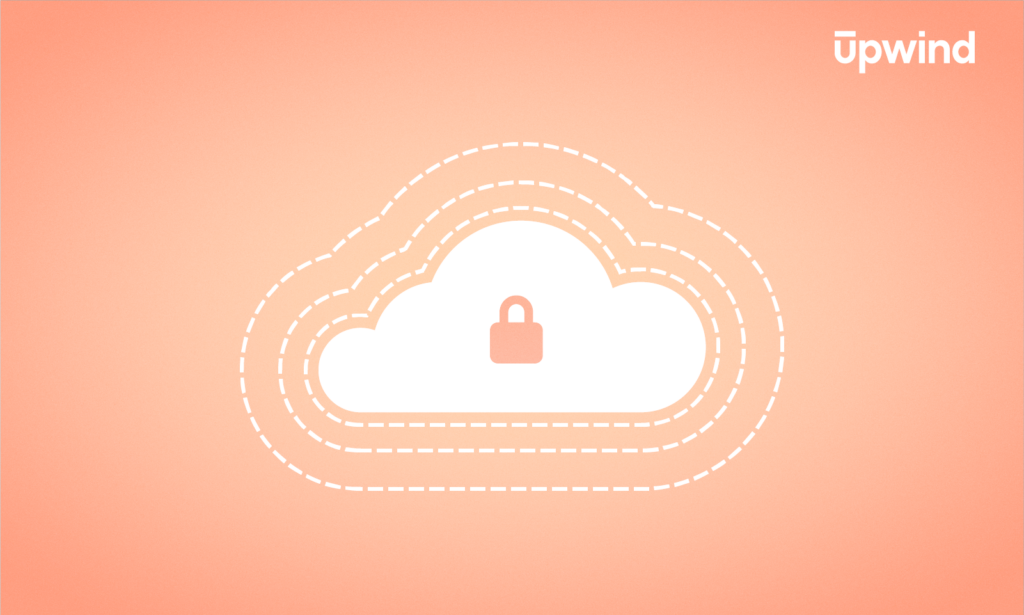
Protecting data in multi-cloud environments is a growing challenge as misconfigurations, unauthorized access, and compliance demands collide with the need for operational agility. The challenge lies in achieving visibility and control over data flows across disparate, multi-cloud infrastructures while maintaining its privacy and eliminating centralized, single points of failure. This article delves into cloud data security, including actionable strategies for maintaining stringent data security.
What is Cloud Data Security?
Cloud data security ensures the confidentiality, integrity, and availability of data in cloud environments. It safeguards against breaches and unauthorized access while maintaining compliance so businesses can protect sensitive information and support secure operations across hybrid and multi-cloud infrastructures.
Data is everywhere. What constitutes sensitive data for organizations today has greatly expanded in type and format. – Forrester.
Data is the lifeblood of modern business; it underpins decision-making, innovation, and operations. As organizations migrate workloads to the cloud to achieve scalability and efficiency, their critical data assets follow, and reside across distributed infrastructures, storage systems, and apps. This migration introduces significant challenges for cloud data security, as data must remain protected while accessible to users, systems, and workflows spread across dynamic, hybrid environments.
Protecting data in the cloud becomes particularly complex due to its fragmented nature and constant motion between storage buckets, APIs, and containerized workloads. Unlike on-premises systems, where data often resides within clearly defined boundaries, cloud infrastructures introduce risks like inconsistent encryption, misconfigurations, and overly permissive access controls. The rise of machine identities, such as APIs and service accounts, further complicates matters by creating pathways for unauthorized access if not properly managed.
Protect Data with Runtime and Container Scanning with Upwind
Upwind offers runtime-powered container scanning features so you get real-time threat detection, contextualized analysis, remediation, and root cause analysis that’s 10X faster than traditional methods.
Critical Cloud Data Security Challenges
Cloud data security challenges are rooted in the complexity of managing data across fragmented infrastructures, where visibility, consistency, and control often fall short. That’s different from on-premises environments, where data often resides within clearly defined boundaries. Below is a breakdown of the most pressing challenges.
Fragmented Data Flows
Data in the cloud moves continuously between storage systems, APIs, and applications, often across multiple regions and providers. This constant movement of data increases the risk of security lapses, where admins might fail to apply encryption uniformly, or misconfigurations might expose sensitive information to unauthorized access.
APIs, as the backbone of modern cloud workloads, enable seamless communication between systems and services but also contribute to fragmented data flows. When APIs are over permissioned or lack proper authentication, they can expose sensitive data as it moves between regions, providers, and services, increasing the risk of unauthorized access within fragmented cloud environments.
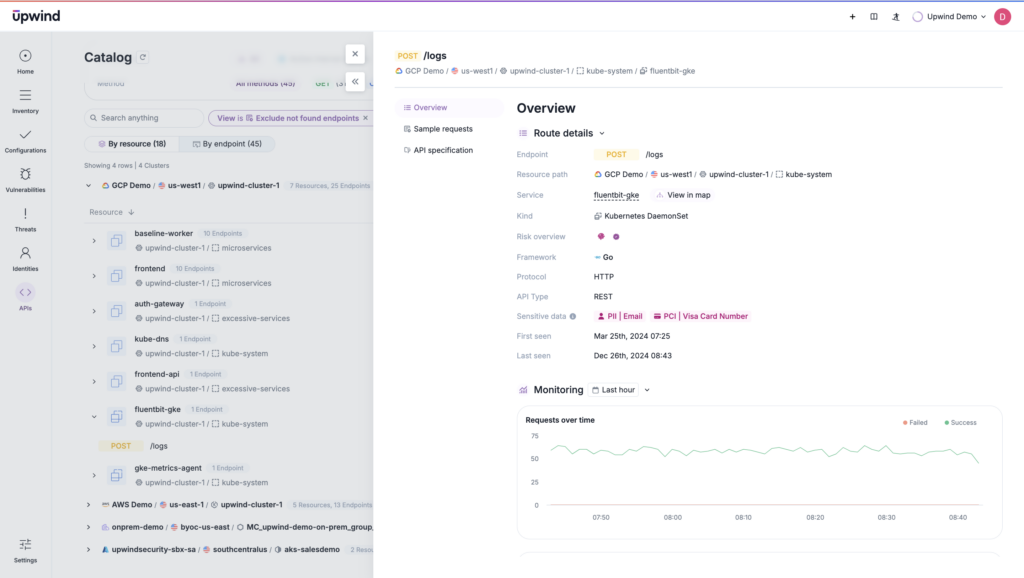
Data Visibility
Gaining comprehensive visibility into where data resides and how it moves is one of the toughest challenges in cloud data security.
The distributed nature of multi-cloud infrastructures often results in silos, where different cloud providers use unique tools and formats for data management. A lack of unified visibility prevents security teams from identifying risks like unauthorized access or unencrypted data. And without real-time insights, organizations are left reactive, and they struggle to detect and mitigate threats before they escalate.
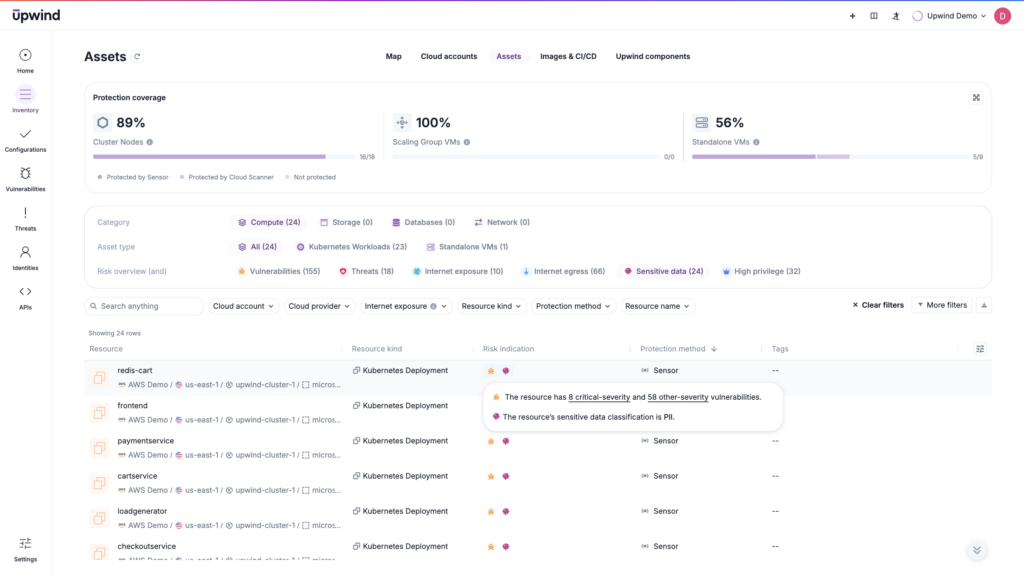
Ephemeral Workloads
Ephemeral workloads, such as containers, introduce unique data security challenges, especially during runtime. While containers can run both on-premises and in hybrid environments, the trend leans heavily toward deploying them in the cloud. Services like Amazon Elastic Kubernetes Service (EKS), Google Kubernetes Engine (GKE), and Azure Kubernetes Service (AKS) dominate, as they offer scalability, agility, and managed services that reduce operational overhead.
Mismanaged secrets, such as hardcoded API keys or credentials within containers, can provide attackers with unauthorized access to critical data. Additionally, runtime vulnerabilities in containerized applications or base images can be exploited to intercept or compromise sensitive information. Misconfigurations in orchestration tools, like overly permissive Kubernetes access controls, further amplify these risks.
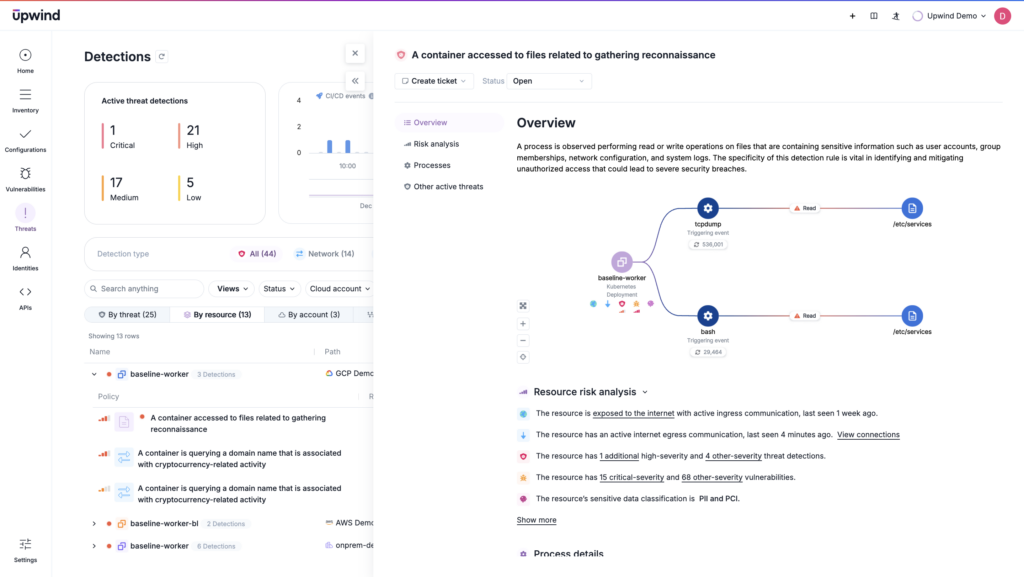
Misconfigurations and Data Exposures
Human error is still the leading cause of cloud data breaches. Common misconfigurations include poorly implemented access controls, overly permissive storage buckets, or neglected encryption settings. The risk of simple human error is amplified in cloud environments due to their complexity and scale. The dynamic nature of cloud infrastructure — where different teams spin up resources rapidly — creates more opportunities for mistakes, while the lack of centralized visibility makes detecting and correcting these errors harder.
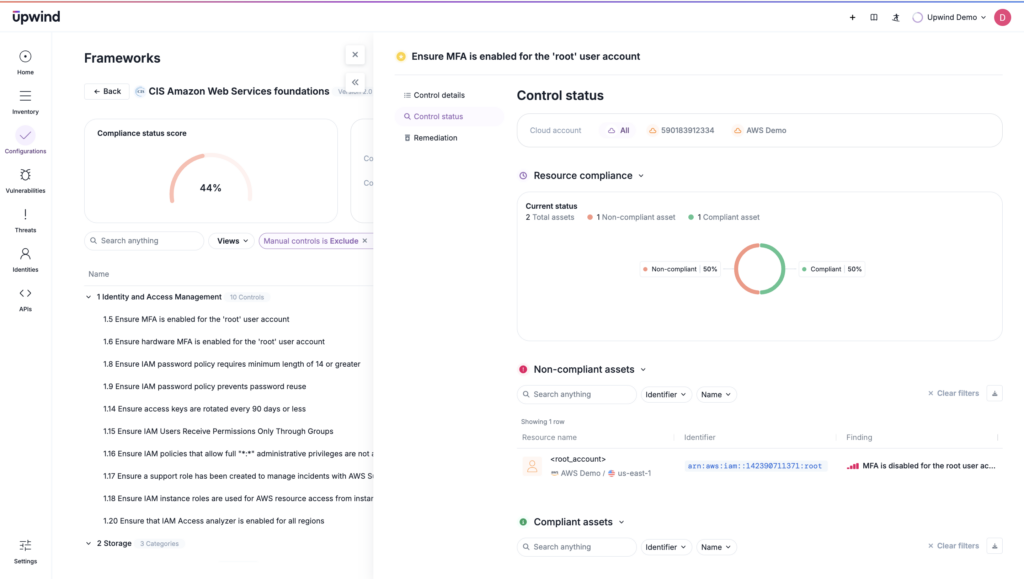
Managing Machine Identities
Machine identities, such as APIs, service accounts, and containers, introduce unique identity challenges. These non-human entities often operate with excessive permissions or outdated credentials and create entry points for attackers. Unlike traditional user accounts, machine identities are harder to monitor and secure, particularly in environments with high automation and frequent deployments.
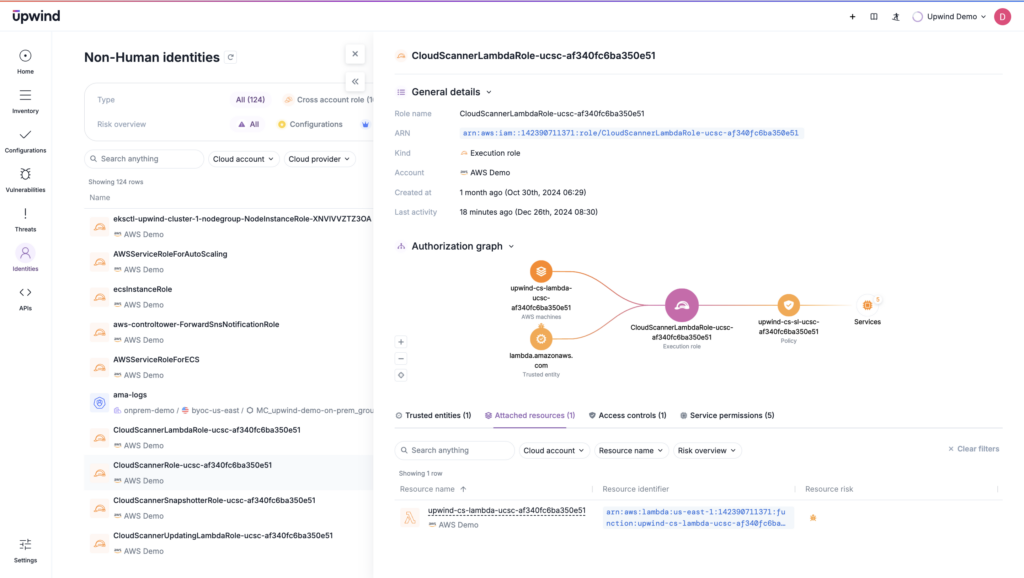
Ultimately, data security challenges in the cloud stem from the unique nature of securing the overall cloud itself. Teams need full visibility, but without siloing data. They rely on fragmented data flows — but, then flows are prone to blind spots and may rely on a patchwork of tools to secure. Bringing together data visibility and secure practices, but distributing them easily across the ecosystem, is key to securing data in the cloud for the long-term, scalable future.
Best Practices for Cloud Data Security Implementation
So how do you do it? Cloud complexities demand targeted best practices beyond the basics of data security to protect cloud data without disrupting the promised innovation, scalability, and efficiency of cloud environments. At its heart are the following best practices.
| Practice | Description |
| Unify Policy Management | Centralize data security policies across cloud providers to reduce inconsistencies and compliance drift. Use tools to enforce uniform encryption, access, and storage policies. |
| Automate Threat Detection | Integrate real-time monitoring with automated response to detect and mitigate threats targeting cloud data. Deploy solutions that identify anomalies, such as suspicious data access or privilege escalations, and trigger automated mitigation actions. |
| Achieve Data Observability | Enhance visibility into how data moves, where it resides, and who accesses it in real time across hybrid or multi-cloud environments. Implement tools that visualize data movement and detect anomalies in data access patterns. |
| Institute Runtime Data Protection | Focus on securing sensitive data within ephemeral workloads, such as containers or serverless functions, where traditional measures fall short. Use tools to detect unauthorized access and flag abnormal behavior in real time, integrating with CI/CD pipelines for rapid response. |
| Automate Secrets Management | Automate the secure storage, rotation, and lifecycle management of credentials, tokens, and API keys to reduce exposure. |
| Establish Dynamic Access Controls | Replace static access controls with dynamic policies that adjust permissions in real time based on context, such as user behavior or location. Use solutions with automatic key rotation and avoid embedding secrets in application code. |
| Automate Compliance Mapping | Map regulatory frameworks to data environments dynamically, ensuring continuous compliance without manual intervention. Use automated tools to map cloud resources to compliance frameworks. |
| Employ Workload Isolation Strategies | Isolate workloads and environments to minimize the blast radius of a breach and enforce tighter security around sensitive data. Enforce namespaces, network segmentation, and workload-specific access controls to secure sensitive data. |
| Detect Behavioral Anomalies | Monitor and analyze data access patterns to detect and respond to abnormal behavior that indicates potential threats. Deploy AI-driven tools that analyze historical trends and flag deviations, such as large-scale data downloads or exfiltration attempts. DLP tools that automatically block certain data-focused actions, like downloading to flash drives, are also helpful. |
| Be Aware of Data Residency | Proactively manage where data resides to align with regional regulations and reduce cross-border data transfer risks. Use data loss prevention (DLP) tools to restrict cross-border transfers and ensure compliance with regional regulations. |
Are these practices beyond the capabilities of CNAPPs? Dedicated runtime-powered CNAPPS can help teams gain clarity into multi-cloud and ephemeral environments, manage misconfigurations, and offer threat detection in real time. But teams may also want to add:
- Automation of secrets management: Including rotating credentials, tokens, and API keys.
- Automating compliance mapping: CNAPPs can automate enforcement across frameworks, but in-depth mapping and some enforcement actions may require a specialized governance platform.
- Data residency needs: DLP tools can enforce regional data residency rules, blocking transfers based on geography.
Why Cloud Data Security Matters More Than Ever
In an era of ransomware and new vulnerabilities logged by the day, data security is an ever-present concern.
“You can now get nearly infinite resources to do things, meaning hackers have more resources at their disposal than ever, as well as bigger potential rewards. The prize for breaking into a bank or a social media company is enormous. If you get in, you have 500 million customers’ data.”
— Joshua Burgin I CPO, Upwind
Cloud data security is more relevant today than at any point in the past. Today, 45% of breaches are cloud-based. They’re driven by major changes in how organizations operate, how data is used, and how threat actors exploit vulnerabilities. The explosive growth of digital transformation, the rise of hybrid work, and evolving cyber threats all contribute, too.
How is the landscape changing in ways that underscore the gravity of the threat? Consider these emerging issues to fold into organizational strategies.
Evolving Threat Actor TTPs
Threat actors have adapted their tactics, techniques, and procedures (TTPs) to exploit the unique vulnerabilities of cloud environments. According to the Cybersecurity & Infrastructure Security Agency (CISA), attackers adapt to accommodate their tactics to organizations’ modernized cloud ecosystems.
Ransomware operators now target cloud backups and distributed storage, while data exfiltration attacks focus on weak points like unsecured APIs or overly permissive storage buckets. Threat actors have a rich environment to work with as they change tactics. They might, for instance, concentrate on identity and access management (IAM) in attacks, like registering unauthorized devices with cloud tenants or exploring cloud-to-on-premise pivoting.
AI-Driven Data Exploitation
Threat actors increasingly use artificial intelligence (AI) advancements to enhance their attacks, from automated scans for misconfigured cloud storage to machine-learning-powered credential cracking. For example, machine learning algorithms have drastically sped up the process of cracking passwords required to infiltrate systems (in one study, 51% of passwords could be cracked within seconds).
This shift means that traditional, static defenses no longer suffice. Organizations must embrace cloud-specific security solutions — including AI — capable of identifying and mitigating threats in real time to counter the speed of AI attacks.
Regulations Demand More — and So Do Customers
Stringent regulations like GDPR, HIPAA, and CCPA call for data protection strategies with continuous validation and demonstrable compliance. While cloud vendors provide foundational compliance measures (e.g., infrastructure certifications and shared responsibility documentation), the complexity lies in determining what falls under the vendor’s purview versus the customer’s.
Misunderstandings about these boundaries can lead to gaps in compliance, especially when customers assume vendors manage responsibilities that are actually theirs, such as securing workloads, managing access controls, or monitoring runtime data.
Further, new regulations emerge all the time, sometimes with cloud-specific rules. Simultaneously, privacy-conscious customers demand more transparency about how their data is handled. This includes how it moves between different cloud systems, services, and apps.
Data as the Lifeblood of Innovation
In a digital-first world, data fuels innovation. Businesses rely on cloud-hosted insights to refine products, improve customer experiences, and optimize operations. However, this growing reliance on data creates a paradox: the more critical data becomes to business success, the greater the risk when it’s compromised. A single breach can stall innovation, undermine customer trust, and even disrupt market momentum.
Enforce Consistent Cloud Security Policies with Upwind
Navigating the complexities of cloud security demands a unified approach that addresses visibility gaps, fragmented tooling, and the challenges of scaling policies across diverse cloud environments. Upwind’s CNAPP eliminates obstacles by bringing clarity and control to multi-cloud ecosystems.
Our targeted approach to cloud data security — spanning visibility, real-time response, and effective risk prioritization — ensures organizations can safeguard their most valuable assets in a nefarious threat landscape.
FAQ
How do you maintain data privacy across multiple clouds?
To maintain data privacy across multiple clouds, a mixed strategy with multiple parts is required. Some pieces are difficult, like managing third-party vendor risks, and maintaining compliance with data residency and privacy laws that shift across regions. Other challenges include protecting data that’s distributed across clouds. The foundational steps are:
- Implementing a unified data governance framework. Define who owns data, how it’s classified, and where it can reside based on regulatory and business needs. This framework standardizes privacy policies and ensures all cloud environments follow the same data management rules.
- Enforcing consistent access controls. Apply role-based permissions, enforce least-privilege access, and use identity management tools for tasks like multi-factor authentication. That prevents unauthorized users from accessing sensitive data, reducing the risk of breaches.
- Encrypting data in transit and at rest. Use strong encryption protocols (e.g., AES-256) to protect data while being transmitted and stored. Even if data is intercepted or accessed improperly, it will remain unreadable.
- Using tools like a CNAPP. You’ll be able to monitor sensitive data, detect unusual access patterns, and identify misconfigurations. You’ll also get deep visibility across multiple cloud environments for real-time risk detection and compliance enforcement.
What encryption standards should organizations use?
Organizations should use AES-256 for encrypting data at rest and TLS 1.2 or higher for data in transit.
AES-256 is widely recognized for its strength, offering 256-bit key encryption that meets compliance requirements like GDPR, HIPAA, and PCI-DSS. Transport Layer Security (TLS) 1.2 or higher secures communications through encryption and authentication. It ensures that sensitive data like login credentials and financial information can’t be intercepted during transfer.
For hybrid environments, ensure compatibility with the cloud provider’s native encryption services and consider end-to-end encryption for added protection.
What role does automation play in cloud data security?
Automation improves cloud data security by enabling continuous monitoring, real-time threat detection, and proactive remediation. It reduces human error by managing repetitive tasks like vulnerability patching, policy enforcement, and access reviews. Where will teams see the most value?
- Threat detection and response: With machine-learning-powered tools to detect suspicious activities better.
- Misconfiguration management: With automated audits to identify and correct cloud misconfigurations, reducing exposure to breaches.
- Data classification and protection: Cataloging sensitive data and enforcing security policies like encryption and restricted access.
- Compliance and reporting: Continuously verifying compliance with standards like GDPR or HIPAA.
- API Security, handled dynamically: Automatically adjusting permissions and monitoring traffic patterns, even as cloud services scale.
How do you measure cloud data security effectiveness?
Organizations track metrics specific to their security goals, compliance needs, and digital environment. However, there are some three main focus areas that can show teams how well their cloud data is protected:
- Security Posture: Track misconfiguration rates, compliance scores, and policy enforcement success to evaluate baseline security and adherence to standards.
- Threat Detection and Response: Measure average detection and response times (MTTD/MTTR) and the number of incidents detected and mitigated.
- Data Protection and Access Control: Monitor data encryption coverage, access violations, and API security events to assess data safety and access management.





